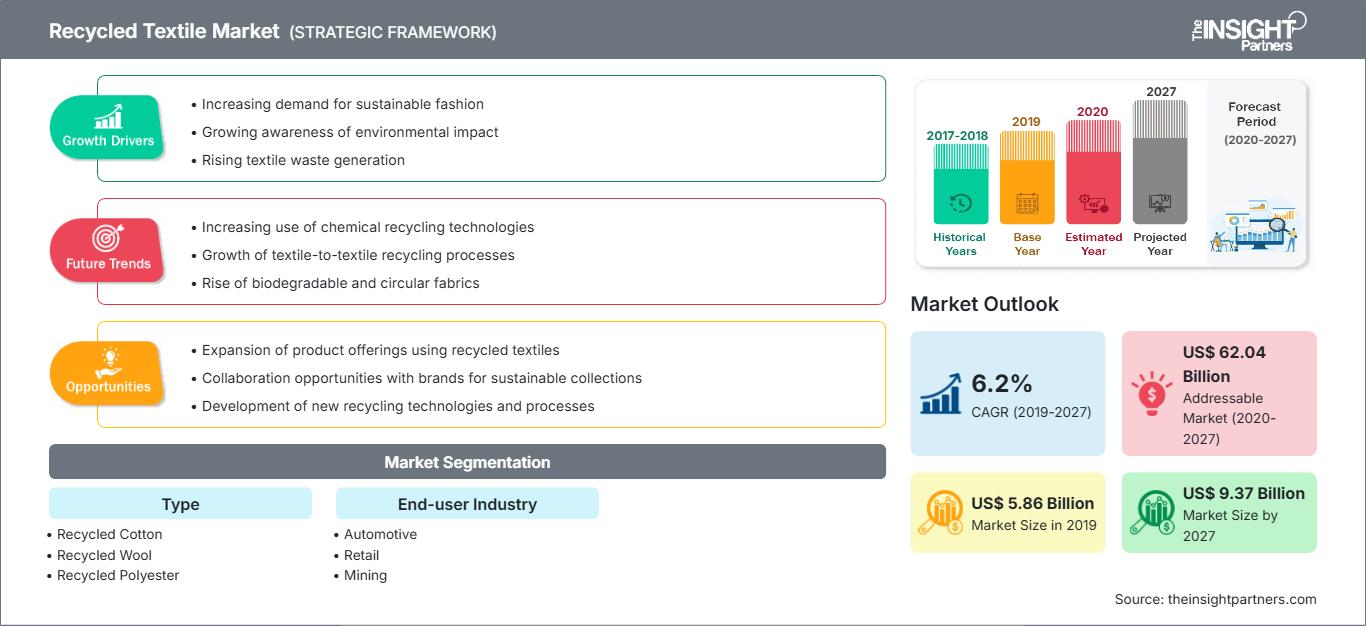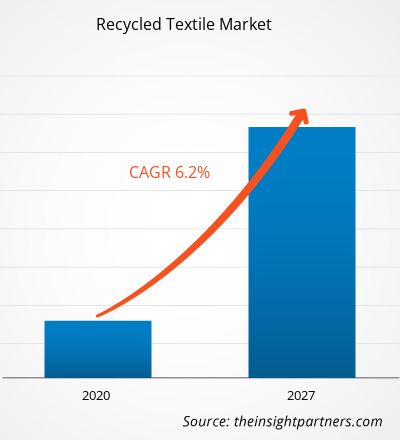재활용 섬유 시장은 2019년 58억 5,539만 달러 규모였으며, 2027년에는 93억 6,504만 달러에 이를 것으로 예상됩니다. 2020년부터 2027년까지 연평균 성장률 6.2%로 성장할 것으로 예상됩니다.
재활용 섬유는 재사용 또는 재료 회수를 위해 회수할 수 있는 헌옷이나 기타 미사용 섬유입니다. 최근 몇 년 동안 전 세계적으로 섬유 폐기물 처리에 대한 우려가 커지고 있으며, 이는 환경에 부정적인 영향을 미칠 수 있습니다. 의류, 직물, 자동차 등 여러 최종 사용 산업의 수요가 급증하면서 전 세계적으로 재활용 섬유 수요가 증가하고 있습니다. 제조업체들은 사용된 섬유를 재활용하여 다양한 최종 사용 산업에 사용될 수 있는 더 나은 제품으로 만들기 위해 여러 기술을 도입했습니다. 자원 재활용은 주로 열, 기계, 화학 기술을 통해 이루어집니다. 유럽은 정부 정책의 강화로 재활용 섬유 시장이 크게 성장했습니다. 또한, 자동차 산업의 재활용 섬유 제품 수요 증가는 재활용 섬유 시장 참여자들에게 수익성 높은 기회를 제공합니다. 구매력 향상과 생활 방식의 변화는 유럽 지역 섬유 시장 성장의 주요 원동력 중 하나입니다. 유럽에서는 소비자가 사용한 의류의 약 15%가 재활용되고, 사용 전 의류의 75% 이상이 제조업체에서 산업용으로 재활용됩니다. 유럽의 재활용 섬유 수요는 지난 몇 년간 가장 빠른 속도로 증가하고 있습니다. 재활용 섬유 생산업체들은 독일, 영국 등의 국가에 집중하고 있으며, 이는 유럽 지역의 재활용 섬유 수요 급증으로 이어졌습니다. 순환 섬유 경제에 대한 소비자들의 관심이 높아지면서 이 지역의 시장 성장이 더욱 가속화될 것으로 예상됩니다. 미국, 브라질, 인도, 러시아, 남아프리카공화국, 멕시코, 스페인, 영국은 2020년 8월 기준 확진자와 사망자 수에서 가장 큰 영향을 받은 국가입니다. COVID-19는 봉쇄, 여행 금지, 사업 중단으로 인해 여러 국가의 경제와 산업에 영향을 미쳤습니다. 글로벌 화학 및 소재 산업은 COVID-19 발생으로 인한 공급망 붕괴, 제조 중단 등 심각한 차질을 겪고 있는 주요 산업 중 하나입니다. 예를 들어, 중국은 세계 제조업의 중심지이자 다양한 산업의 최대 원자재 공급원입니다. 중국을 비롯한 아시아 태평양, 유럽 등 주요 지역의 여러 공장들이 봉쇄되면서 글로벌 공급망이 영향을 받고 있으며, 다양한 제품의 제조, 배송 일정, 판매에도 부정적인 영향을 미치고 있습니다. 이러한 모든 요인들이 글로벌 재활용 섬유 시장에 큰 영향을 미치고 있습니다.
이 보고서의 일부, 국가 수준 분석, Excel 데이터 팩을 포함하여 모든 보고서에 대한 사용자 정의를 무료로 받을 수 있을 뿐만 아니라 스타트업 및 대학을 위한 훌륭한 제안 및 할인을 이용할 수 있습니다
재활용 섬유 시장: 전략적 통찰력

-
이 보고서의 주요 주요 시장 동향을 확인하세요.이 무료 샘플에는 시장 동향부터 추정 및 예측에 이르기까지 데이터 분석이 포함됩니다.
섬유 제조 공정은 화학 물질 집약적인 공정 중 하나로, 운영 전반에 걸쳐 다량의 섬유 폐기물을 발생시킵니다. 섬유 폐기물은 소비 전 섬유 폐기물과 소비 후 섬유, 두 가지 유형으로 구분할 수 있습니다. 섬유 폐기물의 증가는 환경에 부담을 주고 기존 매립지에서 효과적으로 처리하거나 소각하는 문제를 야기합니다. 추산에 따르면, 사용되지 않은 섬유 제품의 약 10~20%가 폐기물로 간주됩니다. 예를 들어, 미국 환경보호청(EPA)에 따르면 2015년에 총 1,575만 톤의 섬유가 도시 고형 폐기물로 발생했으며, 이 중 19%는 소각되었고 65%는 매립되었습니다. 또한, 미국 환경보호청(EPA)의 보고서에 따르면 섬유 생산 및 폐기 과정에서 온실가스가 배출됩니다. 또한, 소각 과정에서 중금속, 다이옥신, 산성 가스, 먼지 입자와 같은 유기 물질이 배출되는데, 이는 인체와 환경 모두에 유해한 것으로 간주됩니다. 또한, 고농도의 독성 물질을 함유하고 있는 잔여재의 처리 또한 심각한 문제로 대두되고 있습니다. 따라서 환경 지속가능성을 증진할 수 있는 재사용 또는 재활용 방법을 통해 섬유 폐기물을 효과적으로 관리하는 것이 매우 중요합니다. 이러한 상황에서 섬유 폐기물 재활용은 천연자원 부담을 줄이고, 매립 공간의 필요성을 최소화하며, 에너지 절약에 도움이 되는 실행 가능한 대안으로 여겨집니다. 더욱이, 섬유 폐기물의 효과적인 관리를 규제하는 엄격한 정부 법률은 폐기물 관련 임박한 문제를 해결하는 지속 가능한 대안으로 섬유 재활용을 장려하기 위한 것입니다.
유형별 인사이트
재활용 섬유 시장은 유형에 따라 재활용 면, 재활용 양모, 재활용 폴리에스터, 재활용 나일론 등으로 구분됩니다. 재활용 나일론 부문은 2019년부터 2027년까지 예측 기간 동안 가장 빠른 성장률을 기록할 것으로 예상됩니다. 재활용 나일론은 산업용 플라스틱, 폐섬유, 제직 공장에서 발생하는 폐기물, 그리고 사용 후 어망을 재활용하여 만들어집니다. 재활용 나일론은 버진 나일론과 동일한 품질을 가진 새로운 나일론으로 재생됩니다. 나일론 가방, 나일론 원단, 나일론 카펫 또한 재활용 나일론으로 가공되어 재사용됩니다. 재활용 나일론의 상당 부분은 어망에서 나옵니다. 이는 해양 쓰레기를 줄이는 훌륭한 해결책이 될 수 있습니다. 나일론 재활용은 나일론에 비해 비용이 많이 들지만, 많은 환경적 이점을 제공합니다. 나일론을 재활용하면 폐기물을 줄이고 제조 과정에서 발생하는 온실가스 배출량을 줄일 수 있습니다. 또한, 석유에 대한 원자재 의존도를 낮출 수 있습니다. 재활용 나일론은 더 이상 사용되지 않는 나일론 제품의 새로운 재활용 방식을 촉진하는 데에도 도움이 됩니다. 대부분의 기계적 재활용 소재는 고온에서 용융되어 오염 물질을 분해하고 재사용 가능한 형태로 변형됩니다. 나일론은 재활용 과정에서 저온에서 용융되어 오염 물질을 남깁니다. 따라서 나일론은 재활용 전에 세심하게 세척해야 합니다.
최종 사용자 산업 분석
최종 사용자 산업을 기준으로 재활용 시장은 자동차, 소매, 광업 등으로 세분화됩니다. 자동차 부문은 2019년부터 2027년까지 예측 기간 동안 가장 빠른 성장률을 기록할 것으로 예상됩니다. 자동차 산업에서 사용되는 재활용 섬유는 자동차 부품 생산에 큰 기여를 합니다. 자동차 분야에서 재활용 섬유는 바닥재, 실내 장식, 안전벨트와 같은 눈에 보이는 부품뿐만 아니라 튜브 및 테이프, 타이어 코드, 에어백 부품, 섬유와 같은 눈에 보이지 않는 재활용 섬유에도 사용됩니다. 재활용 섬유는 인장 강도, 내마모성, 통기성, 압축 저항성, 탄성, 세척 용이성, 난연성, 동적 기후 조건에 대한 저항성 덕분에 자동차 산업에서 사용됩니다. 재활용 면은 시트 충전재 또는 자동차 단열재로 사용됩니다.
Anandi Enterprises, Chindi, Khaloom Textile India Pvt. Ltd., Kishco Group 등은 세계 재활용 섬유 시장의 주요 기업입니다. 이들 기업은 고객 기반을 확대하고 전 세계적으로 상당한 시장 점유율을 확보하기 위해 신제품 개발 및 인수합병(M&A) 전략을 실행하고 있으며, 이를 통해 전 세계적으로 브랜드 인지도를 유지하고 있습니다.
재활용 섬유 시장The Insight Partners의 분석가들은 예측 기간 동안 재활용 섬유 시장에 영향을 미치는 지역별 동향과 요인을 면밀히 분석했습니다. 이 섹션에서는 북미, 유럽, 아시아 태평양, 중동 및 아프리카, 그리고 중남미 지역의 재활용 섬유 시장 부문과 지역별 분포도 살펴봅니다.
재활용 섬유 시장 보고서 범위
| 보고서 속성 | 세부 |
|---|---|
| 시장 규모 2019 | US$ 5.86 Billion |
| 시장규모별 2027 | US$ 9.37 Billion |
| 글로벌 CAGR (2019 - 2027) | 6.2% |
| 이전 데이터 | 2017-2018 |
| 예측 기간 | 2020-2027 |
| 다루는 세그먼트 |
By 유형
|
| 포함된 지역 및 국가 |
북미
|
| 시장 선도 기업 및 주요 회사 프로필 |
|
재활용 섬유 시장 참여자 밀도: 비즈니스 역학에 미치는 영향 이해
재활용 섬유 시장은 소비자 선호도 변화, 기술 발전, 그리고 제품의 이점에 대한 인식 제고 등의 요인으로 최종 사용자 수요가 증가함에 따라 빠르게 성장하고 있습니다. 수요가 증가함에 따라 기업들은 제품 라인업을 확장하고, 소비자 니즈를 충족하기 위한 혁신을 추진하며, 새로운 트렌드를 적극 활용하고 있으며, 이는 시장 성장을 더욱 가속화하고 있습니다.

- 을 얻으세요 재활용 섬유 시장 주요 주요 플레이어 개요
- 글로벌 재활용 섬유 시장의 진보적인 산업 동향은 참여자들이 효과적인 장기 전략을 개발하는 데 도움이 됩니다.
- 선진국과 개발도상국 시장에서 채택한 사업 성장 전략
- 2017년부터 2027년까지의 글로벌 재활용 섬유 시장에 대한 정량적 분석
- 다양한 산업에 걸친 글로벌 재활용 섬유 수요 추정
- 시장 성장을 예측하기 위해 업계에서 활동하는 구매자와 공급업체의 효율성을 보여주는 PEST 분석
- 경쟁적인 시장 시나리오와 글로벌 재활용 섬유 수요를 이해하기 위한 최근 동향
- 글로벌 재활용 섬유 시장 성장을 주도하고 제한하는 요인과 결합된 시장 동향 및 전망
- 글로벌 재활용 섬유 시장 성장과 관련하여 상업적 관심을 뒷받침하는 전략을 이해하여 의사 결정 프로세스
- 다양한 시장 노드에서의 글로벌 재활용 섬유 시장 규모
- 글로벌 재활용 섬유 시장에 대한 자세한 개요 및 세분화와 업계에서의 역동성
- 글로벌 재활용 섬유 영어: 다양한 지역에서 유망한 성장 기회를 가진 시장 규모
유형별 글로벌 재활용 섬유 시장
- 재활용 면
- 재활용 양모
- 재활용 폴리에스터
- 재활용 나일론
- 기타
최종 사용자 산업별 글로벌 재활용 섬유 시장
- 자동차
- 소매
- 광업
- 기타
회사 프로필
- Anandi Enterprises
- Chindi
- Khaloom Textile India Pvt. Ltd.
- Kishco Group
- Usha Yarns Limited
- Hyosung Corporation
- Leigh Fibers Inc.
- Martex Fiber Southern Corporation
- Renewcell AB
- Boer Group
- 과거 분석(2년), 기준 연도, CAGR을 포함한 예측(7년)
- PEST 및 SWOT 분석
- 시장 규모 가치/거래량 - 글로벌, 지역, 국가
- 산업 및 경쟁 환경
- Excel 데이터세트
최근 보고서
사용 후기
구매 이유
- 정보에 기반한 의사 결정
- 시장 역학 이해
- 경쟁 분석
- 고객 인사이트
- 시장 예측
- 위험 완화
- 전략 기획
- 투자 타당성 분석
- 신흥 시장 파악
- 마케팅 전략 강화
- 운영 효율성 향상
- 규제 동향에 발맞춰 대응






















 무료 샘플 받기 - 재활용 섬유 시장
무료 샘플 받기 - 재활용 섬유 시장